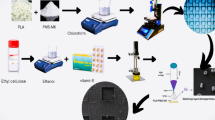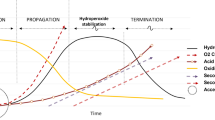Abstract
Purpose
The objective of this study was to formulate and evaluate freeze-dried black raspberry (FBR) ethanol extract (RE) loaded poly(DL-lactic-co-glycolic acid) (PLGA) and poly(DL-lactic acid) (PLA) injectable millicylindrical implants for sustained delivery of chemopreventive FBR anthocyanins (cyanidin-3-sambubioside (CS), cyanidin-3-glucoside (CG) and cyanidin-3-rutinoside (CR)).
Methods
Identification and quantitation of CS, CG, and CR in RE was performed by mass spectroscopy and HPLC. RE:triacetyl-β-cyclodextrin (TA-β-CD) inclusion complex (IC) was prepared by a kneading method and characterized by X-ray diffraction (XRD), nuclear magnetic resonance spectroscopy (NMR) and UV-visible spectroscopy. RE or RE:TA-β-CD IC-loaded PLGA or PLA implants were prepared by a solvent extrusion method. In vitro and in vivo controlled release studies were conducted in phosphate-buffered saline Tween-80 (pH 7.4, 37°C) and after subcutaneous administration in male Sprague-Dawley rats, respectively. Anthocyanins were quantified by HPLC at 520 nm.
Results
The content of CS, CG, and CR in RE was 0.2, 1.5, and 3.5 wt%, respectively. The chemical stability of anthocyanins in solution was determined to be pH-dependent, and their degradation rate increased with an increase in pH from 2.4 to 7.4. PLGA/PLA millicylindrical implants loaded with 5 or 10 wt% RE exhibited a high initial burst and short release duration of anthocyanins (35–52 and 80–100% CG + CR release after 1 and 14 days, respectively). The cause for rapid anthocyanins release was linked to higher polymer water uptake and porosity associated with the high osmolytic components of large non-anthocyanin fraction of RE. XRD, 1H NMR and UV-visible spectroscopy indicated that the non-anthocyanin fraction molecules of RE formed an IC with TA-β-CD, decreasing the hydrophilicity of RE. Formation of an IC with hydrophobic carrier, TA-β-CD, provided better in vitro/in vivo sustained release of FBR anthocyanins (16–24 and 97–99% CG + CR release, respectively, after 1 and 28 days from 20 wt% RE:TA-β-CD IC/PLA implants) over 1 month, owing to reduced polymer water uptake and porosity.
Conclusion
PLA injectable millicylindrical implants loaded with RE:TA-β-CD IC are optimal dosage forms for 1-month slow and continuous delivery of chemopreventive FBR anthocyanins.














Similar content being viewed by others
REFERENCES
Jemal A, Siegel R, Ward E, Hao YP, Xu JQ, Murray T, et al. Cancer statistics. CA-Cancer J Clin. 2008;58:71–96.
Braakhuis BJM, Tabor MP, Leemans CR, van der Waal I, Snow GB, Brakenhoff RH. Second primary tumors and field cancerization in oral and oropharyngeal cancer: molecular techniques provide new insights and definitions. Head Neck-J Sci Spec. 2002;24:198–206.
Malone JP, Stephens JA, Grecula JC, Rhoades CA, Ba BAG, Ghaheri BA, et al. Disease control, survival, and functional outcome after multimodal treatment for advanced-stage tongue base cancer. Head Neck-J Sci Spec. 2004;26:561–72.
Pathak KA, Gupta S, Talole S, Khanna V, Chaturvedi P, Deshpande MS, et al. Advanced squamous cell carcinoma of lower gingivobuccal complex: patterns of spread and failure. Head Neck-J Sci Spec. 2005;27:597–602.
Desai KGH, Mallery SR, Schwendeman SP. Formulation and characterization of injectable poly(DL-lactide-co-glycolide) implants loaded with N-acetylcysteine, a MMP inhibitor. Pharm Res. 2008;25:586–97.
Mallery SR, Zwick JC, Pei P, Tong M, Larsen PE, Shumway BS, et al. Topical application of a bioadhesive black raspberry gel modulates gene expression and reduces cyclooxygenase 2 protein in human premalignant oral lesions. Cancer Res. 2008;68:4945–57.
Rodrigo KA, Rawal Y, Renner RJ, Schwartz SJ, Tian QG, Larsen PE, et al. Suppression of the tumorigenic phenotype in human oral squamous cell carcinoma cells by an ethanol extract derived from freeze-dried black raspberries, Symposium on Berries in Cancer Prevention. Lahti: Lawrence Erlbaum Assoc Inc; 2004. p. 58–68.
Rodrigo KA, Rawal Y, Renner RJ, Schwartz SJ, Tian QG, Larsen PE, et al. Suppression of the tumorigenic phenotype in human oral squamous cell carcinoma cells by an ethanol extract derived from freeze-dried black raspberries. Nutr Cancer. 2006;54:58–68.
Shumway BS, Kresty LA, Larsen PE, Zwick JC, Lu B, Field HW, et al. Effects of a topically applied bioadhesive berry gel on loss of heterozygosity indices in premalignant oral lesions. Clin Cancer Res. 2008;14:2421–30.
Ugalde CM, Liu ZF, Ren C, Chan KK, Rodrigo KA, Ling Y, et al. Distribution of anthocyanins delivered from a bioadhesive black raspberry gel following topical intraoral application in normal healthy volunteers. Pharm Res. 2009;26:977–86.
Tian QG, Giusti MM, Stoner GD, Schwartz SJ. Screening for anthocyanins using high-performance liquid chromatography coupled to electrospray ionization tandem mass spectrometry with precursor-ion analysis, product-ion analysis, common-neutral-loss analysis, and selected reaction monitoring. J Chromatogr A. 2005;1091:72–82.
Kresty LA, Morse MA, Morgan C, Carlton PS, Lu J, Gupta A, et al. Chemoprevention of esophageal tumorigenesis by dietary administration of lyophilized black raspberries. Cancer Res. 2001;61:6112–9.
Mallery SR, Stoner GD, Larsen PE, Fields HW, Rodrigo KA, Schwartz SJ, et al. Formulation and in-vitro and in-vivo evaluation of a mucoadhesive gel containing freeze dried black raspberries: implications for oral cancer chemoprevention. Pharm Res. 2007;24:728–37.
Stoner GD, Sardo C, Apseloff G, Mullet D, Wargo W, Pound V, et al. Pharmacokinetics of anthocyanins and ellagic acid in healthy volunteers fed freeze-dried black raspberries daily for 7 days. J Clin Pharmacol. 2005;45:1153–64.
Tian QG, Giusti MM, Stoner GD, Schwartz SJ. Urinary excretion of black raspberry (Rubus occidentalis) anthocyanins and their metabolites. J Agric Food Chem. 2006;54:1467–72.
Hecht SS, Huang CS, Stoner GD, Li JX, Kenney PMJ, Sturla SJ, et al. Identification of cyanidin glycosides as constituents of freeze-dried black raspberries which inhibit anti-benzo[a]pyrene-7, 8-diol-9, 10-epoxide induced NF kappa B and AP-1 activity. Carcinogenesis. 2006;27:1617–26.
Huang CS, Li JX, Song L, Zhang DY, Tong QS, Ding M, et al. Black raspberry extracts inhibit benzo(a)pyrene Diol-epoxide-induced activator protein 1 activation and VEGF transcription by targeting the phosphotidylinositol 3-Kinase/Akt pathway. Cancer Res. 2006;66:581–7.
Wang LS, Hecht SS, Carmella SG, Yu NX, Larue B, Henry C, et al. Anthocyanins in black raspberries prevent esophageal tumors in rats. Cancer Prev Res. 2009;2:84–93.
Mallery SR, Pei P, Kang JC, Ness GM, Ortiz R, Touhalisky JE, et al. Controlled-release of doxorubicin from poly(lactide-co-glycolide) microspheres significantly enhances cytotoxicity against cultured AIDS-related kaposi’s sarcoma cells. Anticancer Res. 2000;20:2817–25.
Weinberg BD, Ai H, Blanco E, Anderson JM, Gao JM. Antitumor efficacy and local distribution of doxorubicin via intratumoral delivery from polymer millirods. J Biomed Mater Res A. 2007;81A:161–70.
Weinberg BD, Blanco E, Lempka SF, Anderson JM, Exner AA, Gao JM. Combined radiofrequency ablation and doxorubicin-eluting polymer implants for liver cancer treatment. J Biomed Mater Res A. 2007;81A:205–13.
Mullen W, Lean MEJ, Crozier A. Rapid characterization of anthocyanins in red raspberry fruit by high-performance liquid chromatography coupled to single quadrupole mass spectrometry. J Chromatogr A. 2002;966:63–70.
Tian QG, Giusti MM, Stoner GD, Schwartz SJ. Characterization of a new anthocyanin in black raspberries (Rubus occidentalis) by liquid chromatography electrospray ionization tandem mass spectrometry. Food Chem. 2006;94:465–8.
Wu XL, Prior RL. Systematic identification and characterization of anthocyanins by HPLC-ESI-MS/MS in common foods in the United States: fruits and berries. J Agric Food Chem. 2005;53:2589–99.
Kirca A, Ozkan M, Cemeroglu B. Effects of temperature, solid content and pH on the stability of black carrot anthocyanins. Food Chem. 2007;101:212–8.
Hubbermann EM, Heins A, Stockmann H, Schwarz K. Influence of acids, salt, sugars and hydrocolloids on the colour stability of anthocyanin rich black currant and elderberry concentrates. Eur Food Res Technol. 2006;223:83–90.
Xiong SY, Melton LD, Easteal AJ, Siew D. Stability and antioxidant activity of black currant anthocyanins in solution and encapsulated in glucan gel. J Agric Food Chem. 2006;54:6201–8.
Kong JM, Chia LS, Goh NK, Chia TF, Brouillard R. Analysis and biological activities of anthocyanins. Phytochemistry. 2003;64:923–33.
Knobloch TJ, Casto BC, Kresty LA, Stoner GD, D’Ambrosio SM, Mallery SR, et al. Bench to bedside: chemoprevention of oral cancer by black raspberries. Cancer Epidem Biomar. 2005;14:2751S–2.
Casto BC, Kresty LA, Kraly CL, Pearl DK, Knobloch TJ, Schut HA, et al. Chemoprevention of oral cancer by black raspberries. Anticancer Res. 2002;22:4005–15.
Blanco E, Weinberg BD, Stowe NT, Anderson JM, Gao JM. Local release of dexamethasone from polymer millirods effectively prevents fibrosis after radiofrequency ablation. J Biomed Mater Res A. 2006;76:174–82.
Shahidi F, Naczk M. Phenolics in food and nutraceuticals. Boca Raton: CRC; 2004.
Dai J, Gupte A, Gates L, Mumper RJ. A comprehensive study of anthocyanin-containing extracts from selected blackberry cultivars: extraction methods, stability, anticancer properties and mechanisms. Food Chem Toxicol. 2009;47:837–47.
Fernandes CM, Ramos P, Falcao AC, Veiga FJB. Hydrophilic and hydrophobic cyclodextrins in a new sustained release oral formulation of nicardipine: in vitro evaluation and bioavailability studies in rabbits. J Controlled Release. 2003;88:127–34.
Ikeda Y, Kimura K, Hirayama F, Arima H, Uekama K. Controlled release of a water-soluble drug, captopril, by a combination of hydrophilic and hydrophobic cyclodextrin derivatives. J Controlled Release. 2000;66:271–80.
Fischer W, Klokkers K. Crystalline cyclodextrin complexes of ranitidine hydrochloride, process for their preparation and pharmaceutical compositions containing the same. US Patent:5,665,767; 1997.
Rao KR, Bhanumathi N, Yadav JS, Krishnaveni NS. Inclusion complex of rifampicin, an anti-tubercular drug, with β-cyclodextrin or 2-hydroxypropyl-β-cyclodextrin and a process thereof. US Patent:7,001,893; 2006.
Huh KM, Ooya T, Sasaki S, Yui N. Polymer inclusion complex consisting of poly(epsilon-lysine) and α-cyclodextrin. Macromolecules. 2001;34:2402–4.
Amato ME, Lipkowitz KB, Lombardo GM, Pappalardo GC. High-field NMR spectroscopic techniques combined with molecular dynamics simulations for the study of the inclusion complexes of α- and β-cyclodextrins with the cognition activator 3-phenoxypyridine sulphate (CI-844). Magn Reson Chem. 1998;36:693–705.
Beni S, Szakacs Z, Csernak O, Barcza L, Noszal B. Cyclodextrin/imatinib complexation: binding mode and charge dependent stabilities. Eur J Pharm Sci. 2007;30:167–74.
Fernandes CM, Carvalho RA, da Costa SP, Veiga FJB. Multimodal molecular encapsulation of nicardipine hydrochloride by β-cyclodextrin, hydroxypropyl-β-cyclodextrin and triacetyl-β-cyclodextrin in solution. Structural studies by 1H NMR and ROESY experiments. Eur J Pharm Sci. 2003;18:285–96.
Ramusino MC, Bartolomei M, Gallinella B. 1H NMR, UV and circular dichroism study of inclusion complex formation between the 5-lipoxygenase inhibitor zileuton and β- and γ-cyclodextrins. J Inclus Phenom Mol. 1998;32:485–98.
Djedaini F, Lin SZ, Perly B, Wouessidjewe D. High-field nuclear-magnetic-resonance techniques for the investigation of a β-cyclodextrin-indomethacin inclusion complex. J Pharm Sci. 1990;79:643–6.
Ma DQ, Rajewski RA, Vander Velde D, Stella VJ. Comparative effects of (SBE)(7 m)-beta-CD and HP-beta-CD on the stability of two anti-neoplastic agents, melphalan and carmustine. J Pharm Sci. 2000;89:275–87.
Ding AG, Schwendeman SP. Acidic microclimate pH distribution in PLGA microspheres monitored by confocal laser scanning microscopy. Pharm Res. 2008;25:2041–52.
Ding AG, Shenderova A, Schwendeman SP. Prediction of microclimate pH in poly(lactic-co-glycolic acid) films. J Am Chem Soc. 2006;128:5384–90.
Shenderova A, Burke TG, Schwendeman SP. Stabilization of 10-hydroxycamptothecin in poly(lactide-co-glycolide) microsphere delivery vehicles. Pharm Res. 1997;14:1406–14.
Shenderova A, Burke TG, Schwendeman SP. The acidic microclimate in poly(lactide-co-glycolide) microspheres stabilizes camptothecins. Pharm Res. 1999;16:241–8.
ACKNOWLEDGEMENT
This study was supported by NIH R01 CA95901 and NIH R01 CA129609. We thank Dr. Scott Woehler, College of Pharmacy, University of Michigan, for the technical assistance with the NMR analysis.
Author information
Authors and Affiliations
Corresponding author
Rights and permissions
About this article
Cite this article
Desai, K.G.H., Olsen, K.F., Mallery, S.R. et al. Formulation and In Vitro-In Vivo Evaluation of Black Raspberry Extract-Loaded PLGA/PLA Injectable Millicylindrical Implants for Sustained Delivery of Chemopreventive Anthocyanins. Pharm Res 27, 628–643 (2010). https://doi.org/10.1007/s11095-009-0038-5
Received:
Accepted:
Published:
Issue Date:
DOI: https://doi.org/10.1007/s11095-009-0038-5




